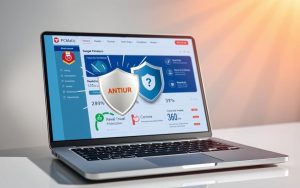Table of Contents
Cloud security has become a critical concern for enterprises as they store data and run applications on infrastructure they don’t directly manage. Implementing cloud security best practices and tools can help businesses protect their data and strengthen their defenses.
Ensuring the security of users and devices connecting to cloud apps is a key aspect of cloud security. Understanding the shared responsibility model and asking detailed security questions to cloud providers are also important steps in improving cloud security.
When it comes to data protection, threat detection, network security, and information privacy in cloud environments, vulnerability assessment, access control, incident response, and risk management play vital roles. By implementing these best practices, organizations can enhance their cloud security and ensure the safety of their sensitive data.
Understanding the Shared Responsibility Model
In the context of cloud security, it is essential to understand the shared responsibility model. Unlike private data centers where enterprises have full control over security, the public cloud operates under a shared responsibility model. This model entails that while the cloud provider assumes some security responsibilities, the ultimate responsibility for the security of data lies with the customer.
Enterprises must familiarize themselves with the division of responsibilities between themselves and the cloud provider. They should have a clear understanding of the areas where they are still responsible for security, such as data encryption and compliance requirements. While the cloud provider takes care of the underlying infrastructure security, enterprises must focus on securing their data within the cloud environment.
To ensure robust security, organizations should implement data encryption measures to protect their sensitive information. Encryption ensures that even if unauthorized entities gain access to the data, they are unable to decipher it without the corresponding decryption key. Compliance requirements also play a crucial role in cloud security. Enterprises must adhere to relevant regulations and standards to protect their data and maintain legal compliance.
The Shared Responsibility Model
| Cloud Provider’s Responsibility | Enterprise’s Responsibility |
|---|---|
| Physical security of data centers | Data encryption |
| Network security | Compliance requirements |
| Host infrastructure security | User access control |
| Application and data security within the cloud | Incident response |
“In the shared responsibility model, cloud providers and enterprises have distinct security responsibilities. While the cloud provider ensures the physical and network security of the data center, enterprises are responsible for implementing data encryption and complying with relevant regulations.”
In conclusion, understanding the shared responsibility model is crucial for effective cloud security. By clearly defining the security responsibilities and implementing appropriate measures, enterprises can ensure the protection of their data within the cloud environment. Data encryption and compliance requirements remain the primary focus for enterprises, while the cloud provider assumes responsibility for overall infrastructure security.
Asking Detailed Security Questions to Cloud Providers
When evaluating cloud providers, it’s crucial to ask detailed security questions to ensure they have adequate security measures in place. By understanding the security protocols and practices of a cloud provider, businesses can make informed decisions about the safety of their data and applications. Here are some important questions to ask:
1. What security measures do you have in place?
Ask the cloud provider about the specific security measures they employ to protect their infrastructure and the data stored within it. This may include firewalls, intrusion detection systems, and encryption techniques. Understanding these security measures will help you evaluate the provider’s ability to protect your data.
2. What is your security incident protocol?
In the event of a security breach or incident, it’s important to understand how the cloud provider will respond and mitigate the impact. Ask about their incident response team, procedures for handling security incidents, and how they communicate with customers during such events.
3. Do you have a disaster recovery plan?
In the event of a disaster or system failure, a cloud provider should have a robust disaster recovery plan in place. Ask about their backup and recovery procedures, including how frequently data is backed up and how long it takes to restore services in the event of an outage.
4. How do you protect against unauthorized access?
Access protection is a critical aspect of cloud security. Ask the cloud provider about their access control mechanisms, including authentication methods, user roles, and permissions. Additionally, inquire about measures they have in place to prevent unauthorized access to your data.
| Questions | Description |
|---|---|
| What security measures do you have in place? | Ask about the specific security measures the provider employs to protect their infrastructure |
| What is your security incident protocol? | Ask about the provider’s incident response team and procedures for handling security incidents |
| Do you have a disaster recovery plan? | Inquire about the provider’s backup and recovery procedures in the event of a disaster or system failure |
| How do you protect against unauthorized access? | Ask about the provider’s access control mechanisms and measures to prevent unauthorized access to data |
By asking these detailed security questions and thoroughly evaluating the cloud provider’s responses, businesses can gain confidence in their ability to protect sensitive data and ensure the security of their cloud environment.
Addressing Risks and Consequences of Inadequate Security Measures
Inadequate security measures in cloud environments can have serious consequences and expose businesses to various risks. The repercussions of insufficient security can include data breaches, downtime, compliance violations, unauthorized access, data loss, and delayed incident response. These consequences can significantly impact the integrity, availability, and confidentiality of sensitive data. Additionally, inadequate incident response can exacerbate the damage caused by hacks or breaches, while limited technical support hinders quick mitigation of security risks. Failure to meet compliance standards can result in regulatory penalties and legal ramifications.
Protecting against these risks requires enterprises to thoroughly examine their cloud provider’s security procedures and assess their own security measures. It is essential to review service-level agreements and ensure they align with the organization’s security requirements. Implementing robust backup strategies for important data and considering alternative providers if necessary can also help mitigate the risks associated with inadequate security measures.
“Inadequate security measures can lead to data breaches, downtime, compliance violations, unauthorized access, data loss, and delayed incident response”
Overall, addressing the risks and consequences of inadequate security measures is crucial for maintaining cloud security. By thoroughly evaluating security procedures, implementing backup strategies, and ensuring compliance with industry regulations, organizations can protect their data, prevent security breaches, and avoid potentially severe penalties.
| Risks | Consequences |
|---|---|
| Data breaches | Exposure of sensitive information to illegal access or theft compromising confidentiality, integrity, and availability of data |
| Downtime | Disruption of services, impacting productivity and potentially resulting in financial losses |
| Compliance violations | Failure to meet regulatory requirements may lead to penalties, fines, and legal consequences |
| Unauthorized access | Potential compromise of data integrity and confidentiality |
| Data loss | Potential permanent loss of data, impacting business operations and customer trust |
| Delayed incident response | Inability to quickly mitigate and recover from security incidents, exacerbating the potential damage |
Implementing Identity and Access Management (IAM) Solutions
Implementing identity and access management (IAM) solutions is crucial for minimizing security risks in cloud environments. IAM helps enforce secure access controls, such as least privilege and role-based access control (RBAC), ensuring that users only have access to the data they need for their tasks. Multi-factor authentication (MFA) adds an extra layer of security, requiring additional verification even if attackers obtain credentials. IAM solutions that work across both private data centres and cloud deployments can streamline user authentication and policy enforcement in hybrid environments.
Identity and access management plays a vital role in securing cloud environments by controlling user access and providing strong authentication mechanisms. By implementing IAM solutions, organizations can adhere to the principle of least privilege, which restricts user permissions to only what is necessary for their role and reduces the attack surface. Role-based access control further enhances security by enabling fine-grained control over user authorizations based on their responsibilities and eliminates unnecessary privileges that could be exploited by attackers.
Another important aspect of IAM is the implementation of multi-factor authentication (MFA). MFA adds an extra layer of security by requiring users to provide additional verification factors, such as a unique code sent to their mobile device, in addition to their username and password. This makes it significantly more difficult for attackers to gain unauthorized access, even if they possess the user’s credentials.
Implementing IAM solutions in hybrid environments allows organizations to unify user authentication and enforce consistent access policies across both on-premises and cloud-based applications. This streamlines user management processes and ensures that security measures are applied consistently, regardless of the deployment environment.
| Key Benefits of Implementing IAM Solutions in Cloud Environments | SEO Keywords |
|---|---|
| Enforces secure access controls | secure access |
| Reduces the attack surface | least privilege |
| Streamlines user authentication | role-based access control |
| Enhances security with multi-factor authentication | multi-factor authentication |
| Ensures consistent access policies in hybrid environments | hybrid environments |
Cybersecurity Awareness Training for Employees
Cybersecurity awareness training plays a crucial role in maintaining cloud security. It is essential for employees to be educated about the risks associated with cloud computing and to understand best practices for data privacy, password management, incident response, and adherence to security policies.
One area of concern in cloud security is the presence of shadow IT, which refers to the use of unauthorized cloud services by employees. Through cybersecurity awareness training, employees can be made aware of the risks and implications of engaging in shadow IT activities. By understanding the potential security vulnerabilities and consequences, employees are more likely to adhere to company policies and use approved cloud services, thereby reducing the risk of data breaches and unauthorized access.
Furthermore, providing training for security personnel is equally important. Security personnel training ensures that they are equipped with the necessary skills and knowledge to effectively detect and respond to cyber threats. This includes training on incident response protocols, identifying and mitigating insider threats, and staying up to date with emerging cybersecurity trends. By investing in the professional development of security personnel, organizations can enhance their overall cloud security posture and effectively mitigate potential risks.
The Importance of Security Policies
In addition to training, the establishment of comprehensive security policies is vital for maintaining cloud security. These policies should clearly outline guidelines and procedures for employees to follow when using cloud services. They should cover areas such as data privacy, acceptable use of cloud resources, incident reporting, and password management. By enforcing security policies, organizations can ensure that employees are aware of their responsibilities and actively contribute to maintaining a secure cloud environment.
Creating a Culture of Security
It is equally important to foster a culture of security within the organization. This involves promoting a sense of ownership and responsibility among employees when it comes to cybersecurity. Regular communication and open discussions about security practices can help employees understand the importance of their actions and encourage them to make informed decisions that prioritize data protection. By creating a culture of security, organizations can significantly reduce the risk of internal security breaches and improve overall cloud security.
| Key Topics in Cybersecurity Awareness Training | Benefits |
|---|---|
| Shadow IT risks and implications | Reduces the use of unauthorized cloud services and minimizes the risk of data breaches. |
| Data privacy and password management | Ensures that sensitive data is protected and that strong passwords are used to prevent unauthorized access. |
| Incident response protocols | Enables employees to respond effectively to security incidents and minimize the impact. |
| Adherence to security policies | Encourages employees to follow established security guidelines and contribute to maintaining a secure cloud environment. |
Establishing Cloud Security Policies
To ensure proper data protection in cloud environments, it is crucial to establish clear cloud security policies. These policies serve as written guidelines outlining the allowed use of cloud services, the security technologies that must be used to protect data and applications, and the specific security measures employees are required to follow. By clearly defining these policies, organizations can prevent unauthorized access, data breaches, and improper data handling.
Cloud security policies should address various aspects such as:
- Cloud Usage: Clearly define what types of cloud services are permissible and how they should be used within the organization.
- Security Technologies: Specify the security technologies and controls that must be implemented to protect data and applications in the cloud environment.
- Data Protection: Outline procedures and best practices for data encryption, access controls, and secure handling of sensitive information.
Regular reviews and updates should be conducted to ensure that the cloud security policies remain effective and aligned with changing security requirements. By following these policies and guidelines, organizations can enhance their overall cloud security posture and minimize the risk of security incidents.

“Establishing clear cloud security policies is essential for ensuring proper data protection in cloud environments.”
Securing Data with Encryption and Access Controls
Securing data in the cloud is crucial for protecting sensitive information from potential data breaches. By implementing data encryption and access control measures, organizations can significantly enhance their cloud security posture and safeguard their valuable data.
Data encryption serves as an effective method to protect data at rest and in transit. By encoding the data, it becomes inaccessible to unauthorized users, ensuring its confidentiality. Implementing strong encryption algorithms and following best practices for encryption key management are essential to maintaining the integrity and security of sensitive data.
In addition to encryption, access controls play a vital role in cloud security. Access controls allow organizations to regulate user access to data and applications based on their roles and privileges. By enforcing the principle of least privilege, organizations can limit access to only necessary resources, reducing the risk of unauthorized access and potential breaches.
| Data Protection Measure | Benefits |
|---|---|
| Data Encryption | – Protects data confidentiality – Prevents unauthorized access – Mitigates the risk of data breaches |
| Access Controls | – Regulates user access based on roles and privileges – Reduces the risk of unauthorized access – Enhances overall data security |
By combining data encryption and access controls, organizations can establish a robust security framework to protect their sensitive data in cloud environments. These measures not only provide protection against external threats but also help organizations meet compliance requirements and build trust with their customers.
Monitoring and Auditing for Security Compliance
Effective monitoring and auditing are crucial components of maintaining robust cloud security and ensuring compliance with industry standards and regulations. Cloud monitoring involves continuously monitoring the infrastructure, applications, and data stored in the cloud to detect and respond to potential security threats promptly. Security logs, which record important events and activities, play a key role in identifying any suspicious or unauthorized access attempts.
To meet compliance requirements, organizations need to have clear visibility into their cloud environment. This includes monitoring user activity, network traffic, and system configurations. Regular audits should be performed to assess the effectiveness of security controls and identify any vulnerabilities or gaps in the security infrastructure. Vulnerability testing, which involves actively looking for weaknesses in the cloud environment, is also crucial for maintaining a strong security posture.
“Regular monitoring and auditing are essential for maintaining cloud security and ensuring compliance with relevant standards and regulations.”
Compliance Requirements and Audits
- Organizations must adhere to specific compliance requirements based on their industry and the type of data stored in the cloud.
- Audits are conducted to assess whether the organization’s cloud security practices align with industry regulations and standards.
- Examples of compliance requirements include the General Data Protection Regulation (GDPR) for protecting personal data, the Payment Card Industry Data Security Standard (PCI DSS) for securing payment information, and the Health Insurance Portability and Accountability Act (HIPAA) for safeguarding medical records.
- During audits, organizations are evaluated on various aspects, such as data protection measures, access controls, incident response procedures, and encryption practices.
Vulnerability Testing
- Vulnerability testing involves identifying weaknesses in the cloud infrastructure and applications that could be exploited by attackers.
- Organizations can conduct vulnerability scanning using automated tools to discover potential vulnerabilities in their cloud environment.
- Penetration testing, on the other hand, involves simulating real-world attacks to test the effectiveness of security controls and identify vulnerabilities that may not be detected by automated scans.
- By regularly conducting vulnerability testing, organizations can proactively address security weaknesses and reduce the risk of data breaches and unauthorized access.
By prioritizing monitoring, security logs, compliance requirements, audits, and vulnerability testing, organizations can significantly enhance their cloud security posture. Timely detection of security incidents, comprehensive auditing, and proactive vulnerability management are key to maintaining a secure and compliant cloud environment.

Protecting Against Insider Threats and Shadow IT
Insider threats and unauthorized shadow IT pose significant risks to cloud security. Organizations must implement robust measures to protect against these threats and safeguard their sensitive data. One of the key challenges is account compromise, where attackers gain unauthorized access to user accounts and exploit them for malicious purposes. This can result in data breaches, data loss, and unauthorized access to critical systems.
Social engineering is another tactic frequently employed by malicious actors to exploit unwitting employees and gain unauthorized access to sensitive information. By manipulating trust and exploiting human vulnerabilities, social engineering attacks can bypass traditional security measures and compromise cloud security.
It is also crucial to address unintentional insider activity, where employees may inadvertently compromise security through actions such as misconfiguring cloud resources or unintentionally sharing sensitive data. Organizations can mitigate these risks by implementing stringent access controls, providing regular cybersecurity awareness training to employees, and maintaining robust monitoring systems to detect and respond to suspicious activities in real-time.

| Threat | Countermeasure |
|---|---|
| Account Compromise | Implement strong authentication methods, such as multifactor authentication, and regularly monitor user accounts for suspicious activity. |
| Social Engineering | Provide comprehensive cybersecurity awareness training to employees, emphasizing the importance of verifying requests for sensitive information and reporting suspicious activity. |
| Unintentional Insider Activity | Enforce strict access controls, conduct regular security audits, and implement automated systems to detect and prevent misconfigurations and unintentional data sharing. |
| Malicious Insider Activity | Implement role-based access controls, conduct background checks on employees with high levels of access, and monitor user activities for unusual or unauthorized actions. |
By adopting a proactive approach to insider threats and shadow IT, organizations can significantly enhance their cloud security posture and protect their critical data from unauthorized access and exploitation.
Implementing Cloud Infrastructure Security Best Practices
When it comes to securing cloud infrastructure, organizations face unique challenges due to the large attack surface, lack of visibility, and complex environments. To mitigate these risks and protect sensitive data, it is essential to implement cloud infrastructure security best practices.
One of the key aspects of cloud infrastructure security is addressing account compromise, which can result from social engineering, shadow IT, unintentional insider activity, or malicious insider activity. By enforcing strong authentication methods, monitoring user activity, and providing cybersecurity awareness training, organizations can minimize the risk of account compromise and unauthorized access.
“Implementing cloud infrastructure security best practices is crucial for organizations to protect their sensitive data and ensure the integrity and availability of their cloud services.”
Visibility is another crucial factor in cloud security. Due to the distributed nature of cloud environments, organizations may lack visibility into their infrastructure and face challenges in identifying potential vulnerabilities or threats. By leveraging cloud monitoring tools, conducting regular audits, and performing vulnerability testing, organizations can enhance visibility and proactively address security risks.
| Security Challenge | Best Practices |
|---|---|
| Lack of Visibility | Implement cloud monitoring tools Conduct regular audits Perform vulnerability testing |
| Account Compromise | Enforce strong authentication methods Monitor user activity Provide cybersecurity awareness training |
| Complex Environments | Implement security controls at each layer Use network segmentation Regularly update and patch systems |
Additionally, complex cloud environments require organizations to implement security controls at each layer, including network, application, and data. This includes using network segmentation, regularly updating and patching systems, and implementing security measures specific to different components of the cloud infrastructure.
By following these cloud infrastructure security best practices, organizations can enhance their overall security posture, protect their sensitive data, and minimize the risks associated with cloud environments.

Conclusion
In conclusion, cybersecurity in cloud environments is a critical aspect of protecting sensitive data and ensuring the safety of cloud services. By implementing best practices such as securing access, managing user privileges, monitoring for suspicious activity, and promoting employee awareness, organisations can enhance their cloud security posture. With a strong focus on data protection, risk management, and incident response, businesses can effectively mitigate the risks associated with cloud computing and achieve a high level of cybersecurity in the cloud.
Cloud security is crucial in safeguarding data and ensuring the integrity of cloud-based operations. By adopting the recommended best practices, organisations can establish a robust security framework that protects against potential threats and vulnerabilities. Implementing secure access controls, monitoring for suspicious activities, and raising cybersecurity awareness among employees are vital steps in maintaining a secure cloud environment.
Furthermore, organisations should continuously evaluate their security measures to stay ahead of evolving cyber threats. Regular audits, vulnerability testing, and compliance assessments ensure that security controls are effective and align with industry regulations. Encryption, secure user authentication, and strict access controls form a solid foundation for data protection in the cloud.
Overall, cybersecurity in cloud environments demands a proactive approach that combines technical measures, employee training, and regular evaluations. By adhering to best practices and prioritising data protection, organisations can confidently leverage cloud technologies while safeguarding their sensitive information and ensuring the highest level of cloud security.
FAQ
What is the shared responsibility model in cloud security?
The shared responsibility model means that while the cloud provider takes on some security responsibilities, the customer is ultimately responsible for the security of their data.
What security questions should I ask when evaluating cloud providers?
Important security questions to ask include the physical location of servers, security incident protocol, disaster recovery plan, access protection measures, technical support level, penetration test results, data encryption practices, access to cloud-stored data, supported authentication methods, and compliance requirements supported.
What are the risks and consequences of inadequate security measures in cloud environments?
Inadequate security measures can lead to data breaches, downtime, compliance violations, unauthorized access, data loss, and delayed incident response.
How can I minimize security risks in cloud environments?
Implementing identity and access management (IAM) solutions, providing cybersecurity awareness training, establishing clear cloud security policies, encrypting data in transit and at rest, and conducting regular monitoring and auditing can help minimize security risks.
How can I protect against insider threats and shadow IT in the cloud?
Measures to protect against these threats include securing user accounts with strong authentication methods, enforcing least privilege, monitoring user activity, and providing cybersecurity awareness training to employees.
What are some best practices for cloud infrastructure security?
Best practices include securing access to the cloud, managing user access privileges, providing visibility through monitoring, securing APIs, conducting security assessments, and ensuring employee awareness and compliance.
Source Links
- https://www.esecurityplanet.com/cloud/cloud-security-best-practices/
- https://www.ekransystem.com/en/blog/cloud-infrastructure-security
- https://www.microsoft.com/en-us/security/blog/2023/07/05/11-best-practices-for-securing-data-in-cloud-services/









